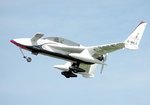wuzak
Captain
Just thought I would do some comparisons.
Bristol Brabazon I
(Data from Bristol Brabazon - Wikipedia)
Crew: 6–12
Capacity: 100 passengers
Length: 177 ft (54.0 m)
Wingspan: 230 ft (70 m)
Height: 50 ft (15 m)
Empty weight: 145,100 lb (65,820 kg)
Max. takeoff weight: 290,000 lb (130,000 kg)
Fuel capacity 13,650 Imp gal (61,971 L)
Powerplant: 8 × Bristol Centaurus radial engines, 2,650 hp (1,860 kW) each
Propellers: paired contra-rotating Rotol, three wooden blades
Propeller diameter: 16 ft (4.9 m)
Performance
Maximum speed: 300 mph (260 kn, 480 km/h) at 25,000 ft
Cruise speed: 250 mph (220 kn, 400 km/h) at 25,000 ft
Range: 5,500 mi (4,800 nmi, 8,900 km) at 250 mph and 25,000 ft
Service ceiling: 25,000 ft (7,600 m) at full weight
Boeing 707-120 (first production variant, 1957)
(data from Boeing 707 - Wikipedia)
Crew: 3 minimum
Capacity: 174 passengers
Length: 145 ft 1 in (44.22 m)
Wingspan: 130 ft 10 in (39.88 m)
Height: 41 ft 8 in (12.70 m)
Empty weight: 127,500 lb (57,600 kg)
Max. takeoff weight: 257,340 lb (117,000kg)
Fuel capacity 17,330USgal (65,590 L)
Powerplant: 4 x Pratt & Whitney JT3D-3, 18,000 lbf (80 kN) thrust each
Performance
Cruise speed: 607 mph (977 km/h)
Range: 3,600 nmi (4,100 mi; 6,700 km)
The Brabazon uses 5% less fuel to go 1/3 further with less than 60% of the paying passengers at less than half the speed. While using more refined fuel.
Granted, the two are about 10 years apart in a period of rapid development, but it shows specific fuel consumption of one engine isn't everything economically.
New York to London is ~3,459 miles.
At cruise speed the 707 would cover that in ~5.7 hours, the Brabazon in ~13.8 hours.
Bristol Brabazon I
(Data from Bristol Brabazon - Wikipedia)
Crew: 6–12
Capacity: 100 passengers
Length: 177 ft (54.0 m)
Wingspan: 230 ft (70 m)
Height: 50 ft (15 m)
Empty weight: 145,100 lb (65,820 kg)
Max. takeoff weight: 290,000 lb (130,000 kg)
Fuel capacity 13,650 Imp gal (61,971 L)
Powerplant: 8 × Bristol Centaurus radial engines, 2,650 hp (1,860 kW) each
Propellers: paired contra-rotating Rotol, three wooden blades
Propeller diameter: 16 ft (4.9 m)
Performance
Maximum speed: 300 mph (260 kn, 480 km/h) at 25,000 ft
Cruise speed: 250 mph (220 kn, 400 km/h) at 25,000 ft
Range: 5,500 mi (4,800 nmi, 8,900 km) at 250 mph and 25,000 ft
Service ceiling: 25,000 ft (7,600 m) at full weight
Boeing 707-120 (first production variant, 1957)
(data from Boeing 707 - Wikipedia)
Crew: 3 minimum
Capacity: 174 passengers
Length: 145 ft 1 in (44.22 m)
Wingspan: 130 ft 10 in (39.88 m)
Height: 41 ft 8 in (12.70 m)
Empty weight: 127,500 lb (57,600 kg)
Max. takeoff weight: 257,340 lb (117,000kg)
Fuel capacity 17,330USgal (65,590 L)
Powerplant: 4 x Pratt & Whitney JT3D-3, 18,000 lbf (80 kN) thrust each
Performance
Cruise speed: 607 mph (977 km/h)
Range: 3,600 nmi (4,100 mi; 6,700 km)
The Brabazon uses 5% less fuel to go 1/3 further with less than 60% of the paying passengers at less than half the speed. While using more refined fuel.
Granted, the two are about 10 years apart in a period of rapid development, but it shows specific fuel consumption of one engine isn't everything economically.
New York to London is ~3,459 miles.
At cruise speed the 707 would cover that in ~5.7 hours, the Brabazon in ~13.8 hours.

